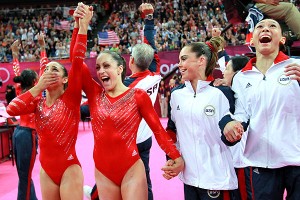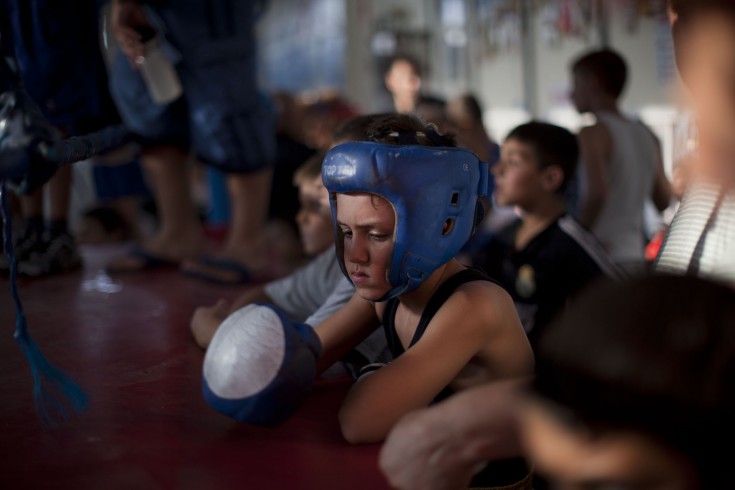I'm a big women's gymnastics fan. Knowing I love dance, sports, and nearly all things feminine and strong, this should come as no surprise. If you know me it's also no surprise that while I took gymnastics as a kid I didn't last long. I was flexible, but I was also fearful (I would think to myself, "Why should I risk falling off that beam when I can read a book about someone else on the beam?"). It's been a thrilling 24 hours for fans of USA gymnastics, with the women's team winning the team gold in decisive fashion.
As Aly Raisman and Gabby Douglas prepare to compete in the All-Around competition I've been preparing for my own All-Around gymnastics meet. My best event is the first- reading- and I'm really trying to up my game in the last event- writing.
1) Reading- Every four years the gymnastics shelf at the library gets restocked. This year the bookshelf is especially full (likely due to the continued popularity of Nastia Liukin, Alicia Sacramone, and Shawn Johnson from the last Games) for both kids and adults.
First is Donna Freitas' Gold Medal Summer, which I especially enjoyed knowing Freitas is a professor (of religion).
The message of Gold Medal Summer-- that you should pursue your dreams and not give them up for romance-- is a good one for young girls (especially because the romance still comes eventually). The protagonist, 14-year-old Joey, has an interesting back story with her sister and family which gives the book more layers than the typical middle school activity-romance-friends storyline.
Two new series about young girls doing gymnastics are also aimed at young readers. The McKenna American Girl books, which I've written about before (and which has now been made into a movie, discussed more below) are better for the elementary school crowd. 1996 Olympic gold medalist Dominique Moceanu lends her name and expertise to another new series, The Go-for-Gold Gymnasts, aimed at middle-grade readers. My favorite was Book 2, Balancing Act, because it obviously is meant to reflect some of Moceanu's own experiences as the child of Romanian immigrants.
I also liked that Moceanu and Thompson present important, and often overlooked, aspects of gymnastics in Balancing Act. They highlight that earning an NCAA scholarship is a worthy and important goal for many gymnasts-- that the Olympics aren't the end-all-be-all for most. They also highlight that there are many hidden costs associated with competitive gymnasts (it's not just tuition and fees but also ace bandages and ice packs and hair accessories). The characters aren't as nuanced as they are in Freitas' book, but the background knowledge is a bit deeper. The New York Times Book Review ran a review of the series and Freitas' book if you're interested in more comparisons. I thought the observation that these particular books do not portray typical stage parents of the main characters is right on, but stage moms do make appearances in other parts of the stories.
In addition to her fictional series Moceanu also just released her memoir, Off Balance. Readers get a sense of her gymnastics training along with an often shocking look at her family life-- including the discovery of a long-lost sister. If you've been watching the Olympics and wondering why Bela Karoyli never mentions Dominique's name, you'll find out why he doesn't by reading Off Balance.
A different new memoir about gymnastics provides some insight as to why people like me-- non-gymnasts-- get so into the sport. Dvora Meyers' ebook Heresy on the High Beam: Confessions of an Unbalanced Jewess, is a quirky look at how love of a childhood sport can continue throughout young adulthood and offer continuity through unstable life stages.
Another quirky, recent book is My Father's Dream of an Olympic Trampoline: Life Story of George Nissen, written by Nissen's daughter Dagmar. Because it's written by his daughter the tone is a bit over-laudatory. But it was fascinating to read about how the trampoline was invented and marketed (and how it got its name from Nissen's time in Mexico). I also found it fascinating how Nissen's experiences as a gymnast and as a diver helped create the trampoline, now used for training in both (if you've been watching the springboard and platform diving you know how acrobatic the divers are).
Why did I include a book about trampolining here? Well it's not just artistic gymnastics that's included in the Olympics, there is also rhythmic gymnastics and trampolining. Yes, trampolining is its own sport in the Olympics as of 2000. I'm actually very excited to watch the Olympic trampolinists who perform some truly out of this world high-flying tricks.
2) Watching- Speaking of watching I try to give my reading eyes a rest by watching television. In addition to coverage of the sport itself (from nationals to Trials to the Olympics) there have been two different television specials about gymnastics.
The first is McKenna Shoots for the Stars, based on the American Girl books. Despite an all-star cast-- including the somewhat head-scratching trio of Nia Vardalos, Ian Ziering, and Cathy Rigby-- the movie is cringe worthy at times thanks to an overly saccharine and staged feel. I actually laughed out loud when McKenna, upset about an injury, melodramatically rips her gymnastics posters off her wall. You can get a taste of it from the trailer if you watch around 1:13.
A more interesting take was a three-part, two-hour long documentary on Aly Raisman, Quest for Gold [now achieved!] shown on the Comcast network (you can also watch all of it in chunks on the website Gymnastike). I fell in love with Aly's father and brother while watching the last part of the documentary. There's a great scene of them watching Aly at Nationals (only her mother went with her to that competition while the rest of the family stayed in Massachusetts) and yelling at the TV for her to stick. If you haven't seen the now viral video of her mom and dad watching her compete bars in Olympic team prelims then you're missing out.
One television show is glaringly absent from my line-up and that's ABC Family's Make It or Break It. I don't have anything against the network (as you know, I've been watching Bunheads), but I never got into this show-- probably because I didn't love the inspiration for it, the movie Stick It.
3) Commenting- While I've converted my husband to the dark side of emotional gymnastics viewing it's still great to commune with other fans via message boards and Twitter. My favorite gymnastics blog is Get a Grip. The author also puts together the wickedly clever and funny Gym Memes.
I tweet about gymnastics fairly often and I love reading comments from gymnastics commentators and expert fans. I put together a public list of those who provide some of the best insight.
While this seems like the shortest event for me (the vault of my All-Around fan experience, if you will), it actually takes up quite a bit of time!
4) Writing- In addition to tweeting and blogging I do write articles. Researching a recent short piece on Brestyan's American Gymnastics Clubs (that appeared in July's Boston Magazine as "From Coddled Kids to World-Class Gymnasts") was great fun because I actually got to see both Aly Raisman and Alicia Sacramone train (for the record they were both vaulting while I watched and Aly also worked on her beam set-- which she'll now be competing on in the Olympic event finals!). I was professional on the outside, but fangirl-y on the inside.
It's been wonderful to see Aly share her gold medal with Mihai Brestyan who is clearly a dedicated, but level-headed, coach. Even during such a busy time Mihai spoke with me for over an hour impressing me with his thoughts on developing young talent in the US. One important point that didn't make it into the printed article is that Bretyan knows not everyone is an Aly or Alicia. He emphasizes NCAA gymnastics as a wonderful outlet, and as a way for families to recoup all they have invested monetarily in gymnastics over the years in the form of a four-year college scholarship. Local news is already reporting families with young girls flocking to the gym in Burlington. While their daughters might not end up as Olympians, or even college athletes, parents should know that Brestyan will help mold their daughters into all-around people.
And All-Around fans like me will enjoy watching from the sidelines.


